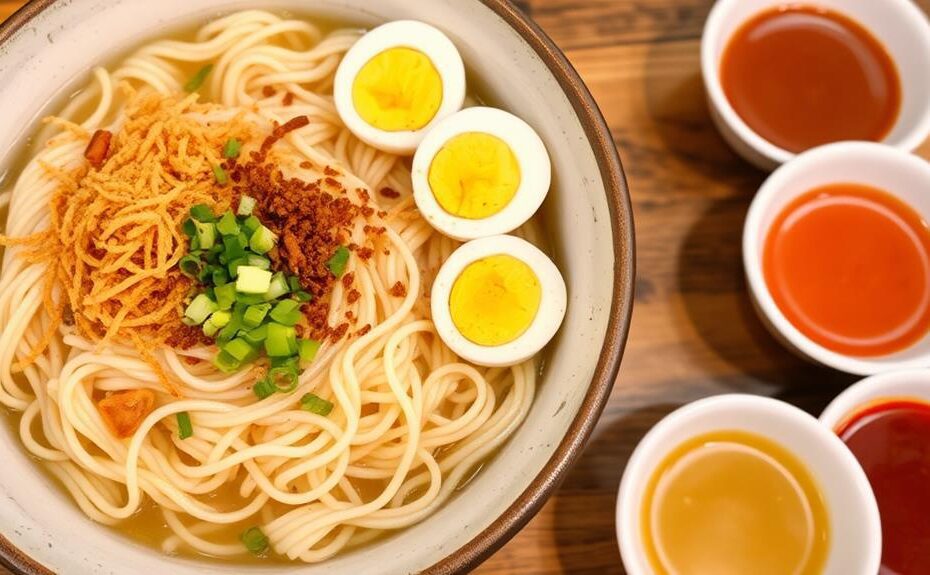Six variations of Pancit Lomi offer distinct twists on the traditional Filipino noodle dish.
Classic Batangas Lomi showcases the rich flavors of the original recipe.
Chicken Lomi provides a lighter alternative, while Vegetarian Lomi caters to plant-based diets.
Seafood Lomi is perfect for those who love seafood, and Pork Belly Lomi indulges with crispy pork belly.
For those who like a little heat, Spicy Lomi is the ideal choice.
Each variation presents nuances and flavors that enhance the overall Pancit Lomi experience.
Exploring Lomi Variations
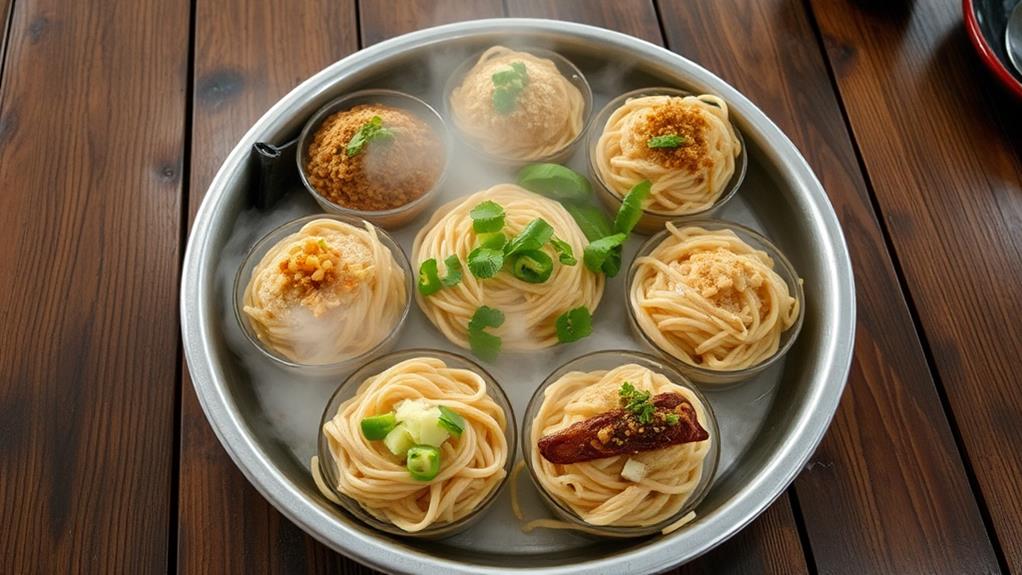
Pancit Lomi Variations Cater to Different Tastes and Preferences
When exploring the world of pancit lomi, you'll find various variations that differ in terms of ingredients, flavors, and textures.
Each variation offers a unique twist on the traditional dish.
Classic Batangas Lomi
The classic Batangas Lomi is known for its thick, somewhat slimy broth and abundance of meat.
This variation stays true to the traditional recipe.
Lighter Options
If you prefer a lighter take, Chicken Lomi is a great alternative.
It features boiled chicken and a flavorful chicken broth.
For a plant-based option, Vegetarian Lomi uses vegetable broth and a mix of mushrooms, tofu, and vegetables.
Seafood Lovers' Delight
Seafood Lomi is a variation that incorporates shrimp, squid, and fish balls for a distinct flavor profile.
This option is perfect for seafood enthusiasts.
Common Thread
Regardless of the variation, all pancit lomi dishes feature signature thick egg noodles and flavorful broth.
This consistency ensures that each variation stays true to the essence of the traditional dish.
Noodle and Broth Essentials
Pancit Lomi's Foundation: Noodles and Broth
The foundation of Pancit Lomi lies in its noodles and broth, which provide the backbone for the dish's varying flavors and textures. Lomi noodles, made from thick egg noodles, have a chewy texture that sets them apart from regular noodles.
This hearty base is essential for balancing the rich flavors that come later.
The Broth: A Crucial Element
The broth is another crucial element, often thickened with a cornstarch slurry to give it a unique, slightly slimy texture.
This texture enhances the overall mouthfeel of the soup, making it a signature characteristic of Filipino cuisine.
You can customize the flavor by using different bases for the broth, such as chicken or pork stock.
Protein and Vegetable Options
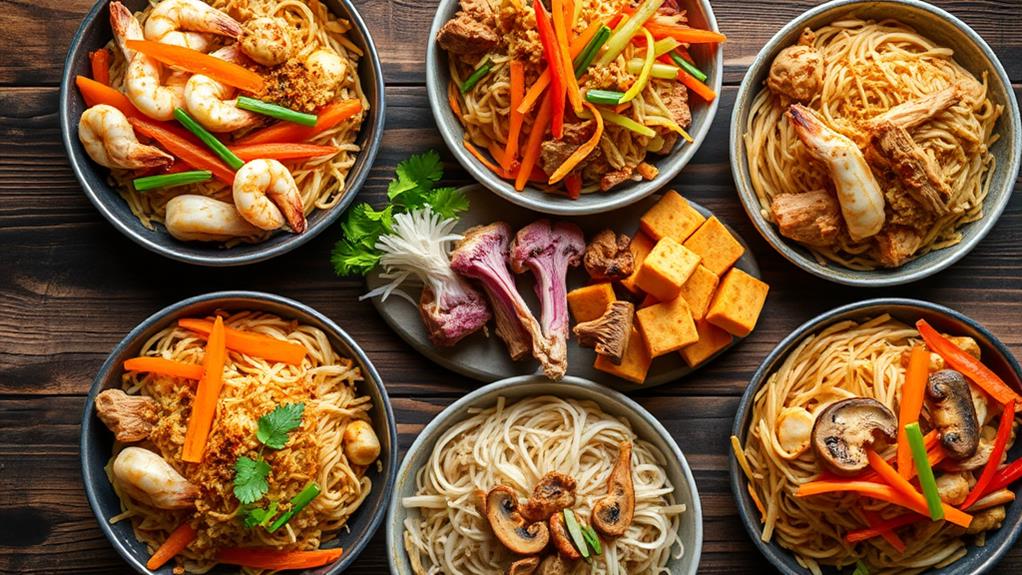
Customizing Pancit Lomi with Protein Sources
Pancit Lomi can be tailored to suit individual tastes and dietary needs by incorporating various protein sources. Chicken, pork, shrimp, beef, or a combination of these are popular options to consider.
For a heartier version, processed meat options like kikiam, squid balls, or fish balls can be added, as seen in some regional recipes of Lomi.
Vegetables for Enhanced Nutrition and Flavor
Vegetables play a crucial role in boosting the nutritional value and freshness of Pancit Lomi. Napa cabbage, carrots, bell peppers, and green onions are ideal additions to create a balanced dish.
For a vegetarian variant, tofu or tempeh can be used as protein substitutes, paired with an array of vegetables to maintain the comforting essence of Pancit Lomi while catering to different dietary needs.
Crispy pork belly, hard-boiled eggs, or chicharrón can be used as toppings to elevate the flavor and presentation of the dish.
Regional Flavors and Influences
Regional Flavors and Influences Shape Pancit Lomi
Pancit Lomi's diversity is a result of regional flavors and influences that have molded the dish over time. Each region in the Philippines has its unique take on this beloved Filipino food.
In Batangas, where Pancit Lomi originated, thick, chewy egg noodles swim in a rich, flavorful chicken broth, often featuring local meats and minimal vegetables.
The Lipa version is particularly famous for its hearty, filling goodness, often loaded with a variety of proteins like kikiam and meatballs.
Meanwhile, Cavite's twist on the classic recipe incorporates local ingredients and flavors, reflecting the region's culinary influences.
Seasonal vegetables and different proteins are often added to showcase local agricultural products and tastes.
Beyond the Philippines, Filipino communities adapt the dish to include available ingredients, maintaining its comforting essence.
Comforting and Nourishing Varieties
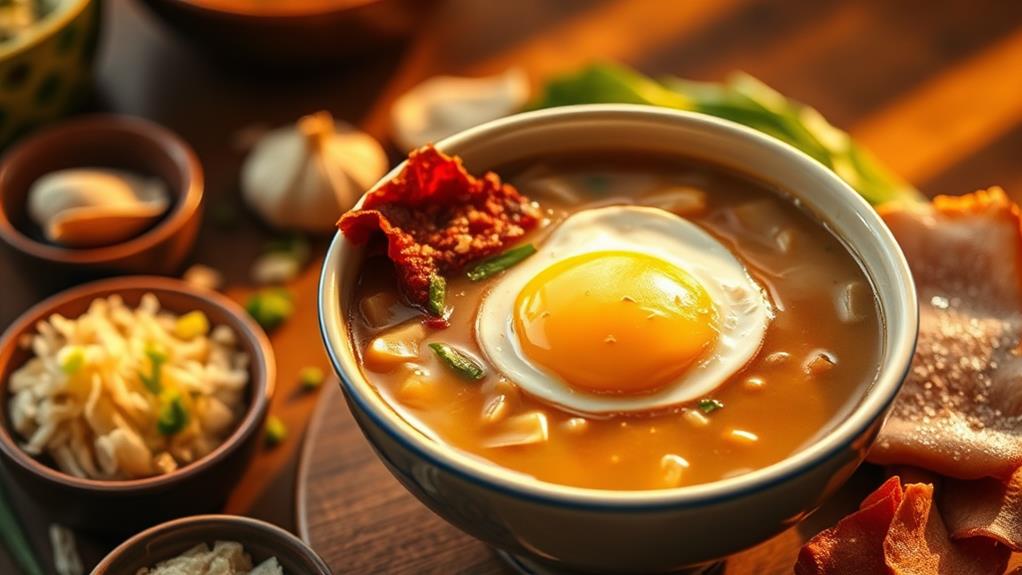
Pancit Lomi enthusiasts often seek variations that still provide a warm, comforting noodle soup experience.
Variations that satisfy this craving include:
- Chicken Lomi, a lighter option that uses boiled chicken for both broth and meat, offering a heartier alternative.
- Seafood Lomi, which incorporates shrimp and squid to enhance the dish's umami flavor and add freshness.
- Vegetarian Lomi, a comforting alternative that replaces meat with tofu and various vegetables, making it suitable for plant-based diets.
- Pork Belly Lomi, an indulgent variation featuring crispy pork belly as a topping, providing a rich and savory contrast to the broth and noodles.
- Spicy Lomi, which infuses the soup with chili peppers or spicy sauces, catering to those who enjoy a little heat in their comfort food.
Cultural Significance of Pancit
Pancit Lomi's Cultural Significance
Pancit Lomi's rich cultural significance reflects the complex history of Filipino cuisine. The dish embodies the country's cultural heritage, shaped by the historical influence of Chinese cuisine. Chinese merchants introduced noodles during trade, which Filipinos adapted to local tastes, resulting in unique variations like Batangas Lomi.
Pancit is a Symbol of Prosperity and Long Life
Pancit is more than just a dish; it's a symbol of prosperity and long life. It's often served during celebrations and gatherings.
The emergence of panciterias during the Spanish colonization period helped popularize pancit as a staple in Filipino cuisine, making it accessible to the masses.
Regional Interpretations of Pancit
Each region in the Philippines contributes its own interpretation of pancit, showcasing local ingredients and cooking styles. This diversity preserves and celebrates the country's cultural heritage.
For example, the Batangas region is known for its Lomi, which is made with thicker noodles and a savory broth. Other regions, like the Visayas, have their own unique pancit variations, such as Pancit Molo, which is made with wonton wrappers and served in a light broth.
Cooking Tips and Techniques
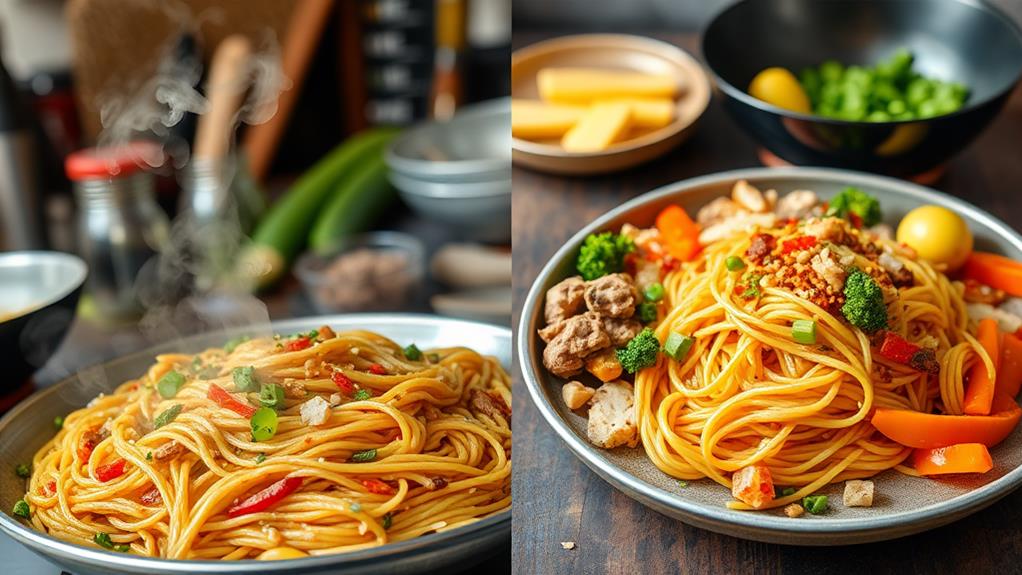
Mastering the Art of Cooking Pancit Lomi
To create an authentic and delicious Pancit Lomi, attention to detail and specific techniques are crucial. Follow these essential cooking tips and techniques to elevate this beloved Filipino dish:
Preparing Lomi Noodles
Blanch lomi noodles in boiling water for 30 seconds to prevent them from becoming mushy. This step ensures the noodles retain their texture and cook evenly.
Thickening the Broth
Use a cornstarch slurry to thicken the broth, mixing the cornstarch with a small amount of cold water before adding it to the simmering soup. This ensures a smooth, velvety texture.
Building Flavor
Sauté garlic and onions until fragrant before adding proteins like pork or chicken. This step builds a flavorful base for the soup, allowing the aromas to meld together.
Adding Vegetables
Incorporate vegetables like napa cabbage and carrots towards the end of cooking to maintain their texture and vibrant color. This ensures the vegetables retain their crunch and flavor.
Balancing Seasoning
Adjust seasoning throughout the cooking process, using ingredients like soy sauce, fish sauce, and calamansi juice to achieve the desired flavor balance. Regularly taste and adjust the seasoning to ensure a harmonious flavor profile.
Customization and Topping Ideas
Customizing Pancit Lomi to Suit Your Taste Preferences
Customizing your Pancit Lomi is all about making it your own by adding the right toppings. Protein-rich toppings like shrimp, pork belly, or chicken enhance the flavor and texture. You can also add seasonal vegetables such as bok choy, carrots, and snow peas to increase the nutritional value and freshness of your dish.
Adding Crunch and Flavor
To give your Pancit Lomi a satisfying crunch, top it with crispy chicharron or lechon kawali. A sliced hard-boiled egg and some fresh scallions will add a pop of color and flavor to your dish.
For an extra kick, try drizzling chili oil or squeezing a bit of calamansi into your Lomi soup.
Experimenting with Combinations
Don't be afraid to get creative with your customization. Try different combinations of toppings to find the perfect blend that suits your taste buds. The key is to experiment and find what works best for you.
How Can I Make Pancit Lomi More Comforting with Different Variations?
When it comes to making pancit lomi more comforting, the key is to experiment with different variations. Adding extra vegetables like carrots and green beans can give it a more refreshing flavor, while incorporating sliced pork or chicken can make it heartier and more satisfying. Ultimately, what makes pancit lomi truly comforting is the ability to customize it to your personal taste preferences.
Flavor Profiles and Pairings

A great Pancit Lomi dish stands out due to its harmonious balance of flavors. This balance can be refined by understanding the interplay of its component parts.
Combining rich and savory flavors creates a solid foundation. Fish sauce and soy sauce provide a rich and savory flavor profile, while thick egg noodles add a hearty texture.
Adding crispy elements introduces depth and contrast. Crispy pork belly or kikiam provides a satisfying crunch, contrasting with the smooth broth.
Seasonal vegetables add sweetness and balance richness. Napa cabbage and carrots contribute sweetness, balancing the richness of the dish and making it more refreshing.
A squeeze of citrus brightens flavors and cuts through heaviness. Calamansi or lemon juice adds a zesty element to each bite, cutting through the richness.
Toppings introduce additional textures and flavors. Hard-boiled eggs and chicharron create a more complex and satisfying eating experience.
Balancing flavors and textures creates a dish greater than the sum of its parts. By combining these elements, a Pancit Lomi dish can be truly exceptional.
Frequently Asked Questions
What Are the Different Types of Pancit?
Pancit is a diverse dish with various types, each offering a unique culinary experience.
Pancit Palabok is a flavorful rice flour noodle dish.
Pancit Canton is a savory wheat noodle stir-fry.
Pancit Bihon is a classic thin rice noodle dish.
Pancit Chami is a sweet and savory variation.
For a more exotic experience, try Pancit Habhab, served on banana leaves, or Pancit Malabon, featuring thick rice-flour noodles and seafood toppings.
What to Pair With Lomi?
Lomi Pairing Options
When choosing what to pair with lomi, consider adding crunchy soup toppings for a delightful contrast. Lechon kawali or chicharron are great options that provide a satisfying textural difference.
To enhance the meal's protein content and texture, serve lomi with side dishes like hard-boiled eggs or lumpiang shanghai (spring rolls).
For added flavor, pair lomi with calamansi or lemon wedges, which provide a burst of citrus flavor. Alternatively, try pickled veggies or a tangy dipping sauce made from soy sauce and vinegar to elevate the dish.
What Is the Difference Between Miki and Lomi?
Miki and Lomi Noodles Have Distinct Textures
Miki noodles have a softer texture, while lomi noodles have a springy texture due to being soaked in lye water.
Different Usage in Recipes
Lomi noodles are typically used in savory broths, such as Pancit Lomi, whereas miki noodles are versatile in cooking techniques.
Ingredient Differences
The main difference between the two noodles is the presence of eggs in lomi, making it higher in protein.
Serving Style Variations
Lomi noodles are often thickened into a saucy soup, whereas miki noodles are typically quickly stir-fried into dishes.
What Is the Most Popular Pancit in the Philippines?
Pancit Canton is the most popular Pancit in the Philippines due to its versatility and flavorful combination of ingredients.
This dish typically consists of a mixture of meats, vegetables, and soy sauce, making it a staple at festive occasions like celebrations and fiestas.
Its cultural significance is highlighted by its frequent presence at these events.
